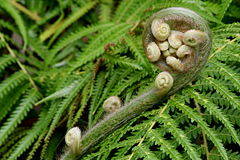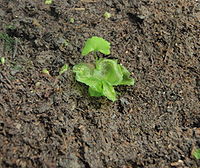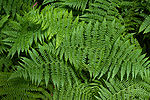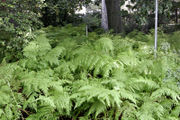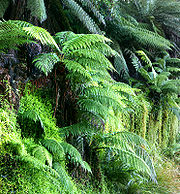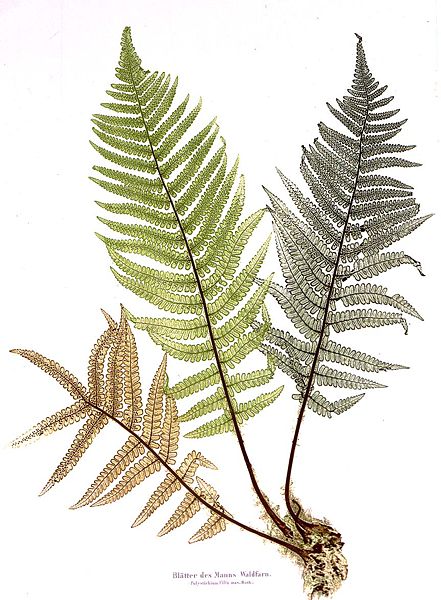Fern
A fern is any one of a group of about 20,000 species of plants classified in the phylum or division Pteridophyta, also known as Filicophyta. The group is also referred to as Polypodiophyta, or Polypodiopsida when treated as a subdivision of tracheophyta (vascular plants). The term "pteridophyte" has traditionally been used to describe all seedless vascular plants, making it synonymous with "ferns and fern allies". This can be confusing since members of the fern phylum Pteridophyta are also sometimes referred to as pteridophytes. The study of ferns and other pteridophytes is called pteridology, and one who studies ferns and other pteridophytes is called a pteridologist.Contents
» Life cycle» Fern ecology
» Fern structure
» Evolution and classification
» Economic uses
» Cultural connotations
» Medicinal Value
» Misunderstood names
» References
Life cycle
Ferns are vascular plants differing from the more primitive lycophytes by having true leaves (megaphylls). They differ from seed plants (gymnosperms and angiosperms) in their mode of reproduction — lacking flowers and seeds. Like all other vascular plants, they have a life cycle referred to as alternation of generations, characterized by a diploid sporophytic and a haploid gametophytic phase. Unlike the gymnosperms and angiosperms, the ferns' gametophyte is a free-living organism.Life cycle of a typical fern:
1. A sporophyte (diploid) phase produces haploid spores by meiosis;
2. A spore grows by mitosis into a gametophyte, which typically consists of a photosynthetic prothallus
3. The gametophyte produces gametes (often both sperm and eggs on the same prothallus) by mitosis
4. A mobile, flagellate sperm fertilizes an egg that remains attached to the prothallus
5. The fertilized egg is now a diploid zygote and grows by mitosis into a sporophyte (the typical "fern" plant).
Fern ecology
The stereotypic image of ferns growing in moist shady woodland nooks is far from being a complete picture of the habitats where ferns can be found growing. Fern species live in a wide variety of habitats, from remote mountain elevations, to dry desert rock faces, to bodies of water or in open fields. Ferns in general may be thought of as largely being specialists in marginal habitats, often succeeding in places where various environmental factors limit the success of flowering plants. Some ferns are among the world's most serious weed species, including the bracken fern growing in the British highlands, or the mosquito fern (Azolla) growing in tropical lakes, both species forming large aggressively spreading colonies.There are four particular types of habitats that ferns are found in: moist, shady forests; crevices in rock faces, especially when sheltered from the full sun; acid wetlands including bogs and swamps; and tropical trees, where many species are epiphytes.
Many ferns depend on associations with mycorrhizal fungi. Many ferns only grow within specific pH ranges; for instance, the climbing fern (Lygodium) of eastern North America will only grow in moist, intensely acid soils, while the bulblet bladder fern (Cystopteris bulbifera), with an overlapping range, is only found on limestone.
Fern structure
Like the sporophytes of seed plants, those of ferns consist of:Stems: Most often an underground creeping rhizome, but sometimes an above-ground creeping stolon (e.g., Polypodiaceae), or an above-ground erect semi-woody trunk (e.g., Cyatheaceae) reaching up to 20 m in a few species (e.g., Cyathea brownii on Norfolk Island and Cyathea medullaris in New Zealand).
Leaf: The green, photosynthetic part of the plant. In ferns, it is often referred to as a frond, but this is because of the historical division between people who study ferns and people who study seed plants, rather than because of differences in structure. New leaves typically expand by the unrolling of a tight spiral called a crozier or fiddlehead. This uncurling of the leaf is termed circinate vernation. Leaves are divided into three types:
Sporophyll: A leaf that produces spores. These leaves are analogous to the scales of pine cones or to stamens and pistil in gymnosperms and angiosperms, respectively. Unlike the seed plants, however, the sporophylls of ferns are typically not very specialized, looking similar to trophophylls and producing sugars by photosynthesis as the trophophylls do.
Brophophyll: A leaf that produces abnormally large amounts of spores. Their leaves are also larger than the other leaves but bear a resemblance to trophopylls.
Roots: The underground non-photosynthetic structures that take up water and nutrients from soil. They are always fibrous and are structurally very similar to the roots of seed plants.
- Prothallus: A green, photosynthetic structure that is one cell thick, usually heart or kidney shaped, 3–10 mm long and 2–8 mm broad. The prothallus produces gametes by means of:
- Antheridia: Small spherical structures that produce flagellate sperm.
- Archegonia: A flask-shaped structure that produces a single egg at the bottom, reached by the sperm by swimming down the neck.
- Rhizoids: root-like structures (not true roots) that consist of single greatly-elongated cells, water and mineral salts are absorbed over the whole structure. Rhizoids anchor the prothallus to the soil.
One difference between sporophytes and gametophytes might be summed up by the saying that "Nothing eats ferns, but everything eats gametophytes." This is an over-simplification, but it is true that gametophytes are often difficult to find in the field because they are far more likely to be food than are the sporophytes.
Evolution and classification
Ferns first appear in the fossil record in the early-Carboniferous period. By the Triassic, the first evidence of ferns related to several modern families appeared. The "great fern radiation" occurred in the late-Cretaceous, when many modern families of ferns first appeared.Ferns have traditionally been grouped in the Class Filices, but modern classifications assign them their own division in the plant kingdom, called Pteridophyta.
» Psilotopsida
» Equisetopsida
» Marattiopsida
» Polypodiopsida
The last group includes most plants familiarly known as ferns. Modern research supports older ideas based on morphology that the Osmundaceae diverged early in the evolutionary history of the leptosporangiate ferns; in certain ways this family is intermediate between the eusporangiate ferns and the leptosporangiate ferns.
Class Psilotopsida
Order Ophioglossales
Family Ophioglossaceae
Order Psilotales
Family Psilotaceae
Class Equisetopsida [=Sphenopsida]
Order Equisetales
Family Equisetaceae
Class Marattiopsida
Order Marattiales
Family Marattiaceae
Class Pteridopsida [=Filicopsida, Polypodiopsida]
Order Osmundales
Family Osmundaceae
Order Hymenophyllales
Family Hymenophyllaceae
Order Gleicheniales
Family Gleicheniaceae
Family Dipteridaceae
Family Matoniaceae
Order Schizaeales
Family Lygodiaceae
Family Anemiaceae
Family Schizaeaceae
Order Salviniales
Family Marsileaceae
Family Salviniaceae
Order Cyatheales
Family Thyrsopteridaceae
Family Loxomataceae
Family Culcitaceae
Family Plagiogyriaceae
Family Cibotiaceae
Family Cyatheaceae
Family Dicksoniaceae
Family Metaxyaceae
Order Polypodiales
Family Lindsaeaceae
Family Saccolomataceae
Family Dennstaedtiaceae
Family Pteridaceae
Family Aspleniaceae
Family Thelypteridaceae
Family Woodsiaceae
Family Blechnaceae
Family Onocleaceae
Family Dryopteridaceae
Family Oleandraceae
Family Davalliaceae
Family Polypodiaceae
To view the complete classification of Kingdom: Plantae click here
Economic uses
Ferns of the genus Azolla are very small, floating plants that do not look like ferns. Called mosquito fern, they are used as a biological fertilizer in the rice paddies of southeast Asia, taking advantage of their ability to fix nitrogen from the air into compounds that can then be used by other plants.
A great many ferns are grown in horticulture as landscape plants, for cut foliage and as houseplants, especially the Boston fern (Nephrolepis exaltata). The Bird's Nest Fern, Asplenium nidus, is also popular, and the staghorn ferns, genus Platycerium, have a considerable following.
Several ferns are noxious weeds or invasive species, including Japanese climbing fern (Lygodium japonicum), mosquito fern and sensitive fern (Onoclea sensibilis). Giant water fern (Salvinia molesta) is one of the world's worst aquatic weeds. The important fossil fuel coal consists of the remains of primitive plants, including ferns.
Ferns have been studied and found to be useful in the removal of heavy metals, especially arsenic, from the soil
Other ferns with some economic significance include:
» Dryopteris filix-mas (male fern), used as a vermifuge, and formerly in the US Pharmacopeia; also, this fern accidentally sprouting in a bottle resulted in Nathaniel Bagshaw Ward's 1829 invention of the terrarium or Wardian case
» Rumohra adiantoides (floral fern), extensively used in the florist trade
» Osmunda regalis (royal fern) and Osmunda cinnamomea (cinnamon fern), the root fiber being used horticulturally; the fiddleheads of O. cinnamomea are also used as a cooked vegetable
» Matteuccia struthiopteris (ostrich fern), the fiddleheads used as a cooked vegetable in North America
» Pteridium aquilinum (bracken), the fiddleheads used as a cooked vegetable in Japan and are believed to be responsible for the high rate of stomach cancer in Japan. It is also one of the world's most important agricultural weeds, especially in the British highlands, and often poisons cattle and horses.
» Diplazium esculentum (vegetable fern), a source of food for some native societies
» Pteris vittata (brake fern), used to absorb arsenic from the soil
» Polypodium glycyrrhiza (licorice fern), roots chewed for their pleasant flavor
» Tree ferns, used as building material in some tropical areas
» Cyathea cooperi (Australian tree fern), an important invasive species in Hawaii
» Ceratopteris richardii, a model plant for teaching and research, often called C-fern
Cultural connotations
"Pteridomania"' is a term for the Victorian era craze of fern collecting and fern motifs in decorative art including pottery, glass, metals, textiles, wood, printed paper, and sculpture "appearing on everything from christening presents to gravestones and memorials." The fashion for growing ferns indoors led to the development of the Wardian case, a glazed cabinet that would exclude air pollutants and maintain the necessary humidity.
The dried form of ferns was also used in other arts, being used as a stencil or directly inked for use in a design. The botanical work, The Ferns of Great Britain and Ireland, is a notable example of this type of nature printing. The process, patented by the artist and publisher Henry Bradbury, impressed a specimen on to a soft lead plate. The first publication to demonstrate this was Alois Auer's The Discovery of the Nature Printing-Process.
Medicinal Value
Ferns are sometimes used in medicine to treat cuts and clean them out. Ferns are also good bandages if you are stuck out in the wild. Rubbing a sword fern frond spore-side-down on a stinging nettle sting removes the stinging.Misunderstood names
Several non-fern plants are called "ferns" and are sometimes confused with true ferns. These include:» "Asparagus fern" — This may apply to one of several species of the monocot genus Asparagus, which are flowering plants.
» "Sweetfern" — A flowering shrub of the genus Comptonia.
» "Air fern" — A group of animals called hydrozoan that are distantly related to jellyfish and corals. They are harvested, dried, dyed green, and then sold as a "plant" that can "live on air". While it may look like a fern, it is merely the skeleton of this colonial animal.
» "Fern bush" — Chamaebatiaria millefolium — a rose family shrub with fern-like leaves.
In addition, the book Where the Red Fern Grows has elicited many questions about the mythical "red fern" named in the book. There is no such known plant, although there has been speculation that the oblique grape-fern, Sceptridium dissectum, could be referred to here, because it is known to appear on disturbed sites and its fronds may redden over the winter.
References
- Wattieza, Stein, W. E., F. Mannolini, L. V. Hernick, E. Landling, and C. M. Berry. 2007. "Giant cladoxylopsid trees resolve the enigma of the Earth's earliest forest stumps at Gilboa", Nature (19 April 2007) 446:904–907.
- Smith, A.R.; Pryer, K.M.; Schuettpelz, E.; Korall, P.; Schneider, H.; Wolf, P.G. (2006). "A classification for extant ferns". Taxon 55 (3): 705–731.
- Pryer, Kathleen M., Harald Schneider, Alan R. Smith, Raymond Cranfill, Paul G. Wolf, Jeffrey S. Hunt and Sedonia D. Sipes. 2001. Horsetails and ferns are a monophyletic group and the closest living relatives to seed plants. Nature 409: 618–622
- Pryer, Kathleen M., Eric Schuettpelz, Paul G. Wolf, Harald Schneider, Alan R. Smith and Raymond Cranfill. 2004. Phylogeny and evolution of ferns (monilophytes) with a focus on the early leptosporangiate divergences. American Journal of Botany 91:1582–1598
- Moran, Robbin C. (2004). A Natural History of Ferns. Portland, OR: Timber Press.
- Lord, Thomas R. (2006). Ferns and Fern Allies of Pennsylvania. Indiana, PA: Pinelands Press.
- Smith, A. R., K. M. Pryer, E. Schuettpelz, P. Korall, H. Schneider & P. G. Wolf. 2006. A classification for extant ferns. Taxon 55(3):705–731.
- Boyd, Peter D. A. (2002-01-02). Pteridomania - the Victorian passion for ferns. Revised: web version. Antique Collecting 28, 6, 9–12.
